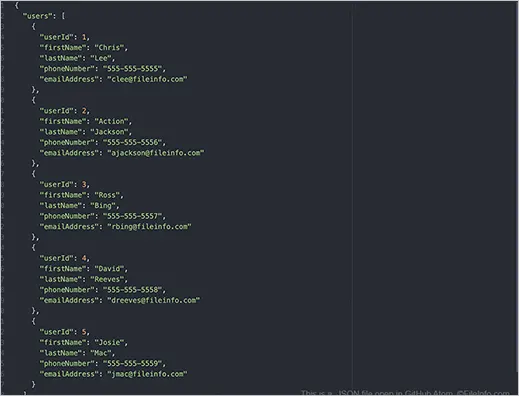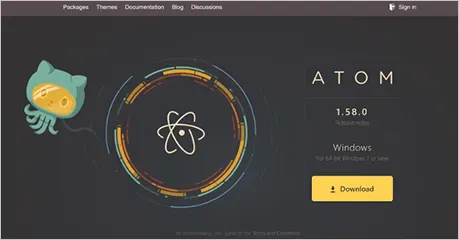JSON files have gained immense popularity as a means of storing and exchanging data within the realm of web development. Unlike bulky and verbose formats such as XML, it is lightweight, effortlessly readable and writable, and straightforward for machines to interpret and create. It is also compatible with numerous programming languages, environments, and libraries.
In this article, we will get into the essence of .json files and their utilization in web development. Furthermore, we will also provide you with information on how to open a JSON file through a range of tools and options.
What is a JSON File?

Data sets with simple structures are often stored in JavaScript Object Notation (JSON) file format. It is a lightweight, text-based data interchange format that is easily readable by humans. It has a .json file extension and shares similarities with XML.
Initially, it was based on a subset of JavaScript. However, it has evolved to become a language-independent format that is supported by numerous programming APIs. It is commonly used in the programming of Ajax Web applications and has gained popularity as an alternative to XML.
While it is widely utilized for data interchange between connected computers, it is not commonly used for data storage. This is because the primary purpose of an open JSON file is to facilitate data exchange over the Internet. Nevertheless, certain platforms, like Google+, offer users the capability to store their profile information in .json file format.
To obtain your profile data from Google+, simply go to the data liberation page and choose the appropriate download option to retrieve your profile data.
In addition to Google+, Firefox also uses the .json file extension to store backup copies of user-created bookmarks. In the event of losing bookmark information, it is possible to reconstruct it using the data stored in the file.
File Structure of JSON Files
Data stored in JSON file format follows a specific structure known as key/value pairs. In this structure, each pair comprises a key and its corresponding value, with a colon acting as the separator between them.
To ensure consistency, the key is enclosed within double quotation marks and placed on the left side, while the value resides on the right side. To accommodate multiple pairs, they are separated by commas. It’s important to note that values can vary in type and can represent different data entities.
- Number: A numerical value.
- String: A sequence of Unicode characters enclosed in double quotation marks.
- Boolean: Either “True” or “False.”
- Array: A collection of values enclosed in square brackets, such as:
[“Apple,” “Banana,” “Orange”]
- Object: A grouping of key/value pairs enclosed in curly braces, such as:
{“name”: “Jack”, “age”: 30, “favoriteSport”: “Football”}
JSON objects have the capability to be arranged in a hierarchical manner, which permits the depiction of intricate data structures. To illustrate this concept, consider the subsequent instance of a nested JSON object:
| { “name”: “Jack”, “age”: 30, “contactNumbers”: [ { “type”: “Home”, “number”: “123 123-123” }, { “type”: “Office”, “number”: “321 321-321” } ], “spouse”: null, “favoriteSports”: [ “Football”, “Cricket” ] } |
How To Open JSON File?
Opening JSON files is a straightforward process that doesn’t require advanced technical skills. Being a text-based data structure, it primarily deals with strings and numbers. Consequently, various file-opening tools can be used to open .json files, such as basic notepads, text editors, and command-line interfaces.
Let’s explore a few examples of programs and applications and learn how to read JSON files:

Developed by Microsoft for Windows operating systems, Windows Notepad serves as a simplistic text editor. Given the simplicity of files, this editor is an effective choice for viewing and making edits to JSON files.

Notepad++ is another source code editor that facilitates the examination and modification of text and programming files. Unlike Windows Notepad, Notepad++ offers greater flexibility in terms of editing capabilities.
Built using C++, it ensures faster performance and lower resource consumption. It proves to be a suitable option to open a JSON file due to the straightforward syntax and nature of the data.

Atom, created by GitHub, is a feature-rich text editor designed for multiple platforms. It surpasses standard editors in complexity and offers contextual syntax highlighting, making it user-friendly. With its versatility in opening various file types, Atom serves as a solid mid-tier editor for viewing and manipulating JSON files, along with many other file formats.

Microsoft Visual Studio Code (VSC) stands out as a highly capable text editor that falls under the integrated development environment (IDE) umbrella.
This versatile software proves invaluable when it comes to handling various file formats and programming languages, empowering users. JSON files, in particular, find themselves seamlessly integrated into VSC, affirming its position as an influential tool for data analysis.
Benefits and Use Cases of JSON File Format
JavaScript Object Notation offers numerous advantages and finds wide application in various scenarios. Below are some key benefits and common uses of JSON files:
1. Simplicity and Readability: JSON files utilize a simple syntax that is easily comprehensible to both humans and machines. The format is concise, enabling a clear and organized representation of complex data structures.
2. Lightweight and Efficient: These files possess a smaller file size compared to formats like XML, resulting in enhanced efficiency for data transmission and storage. This leads to faster loading times and reduced bandwidth usage.
3. Broad Language Support: It enjoys widespread support across multiple programming languages. Many modern languages incorporate built-in functions or libraries specifically designed for parsing and manipulating their data.
4. Web API Integration: It commonly serves as a data transmission format in web development, facilitating a seamless exchange of information between clients and servers. Numerous web APIs deliver data in JSON file format, simplifying the consumption and processing of received data by web applications.
5. Configuration Files: JSON files often serve as repositories for storing configuration settings of applications and systems. The flexibility allows for easy customization and modification of these settings, making it a popular choice for configuration files.
6. Data Storage and Exchange: They provide a reliable and flexible means of storing and exchanging structured data. They efficiently represent various types of information, such as user profiles, product details, and more.
7. Data Interoperability: Its simplicity and compatibility make it an ideal choice for facilitating data interchange between diverse systems. It bridges the gap between applications and databases that employ different data formats, thereby facilitating seamless data integration and interoperability.
What is the Maximum Size of a JSON file?
The size of a JSON file can be quite extensive, with virtually no fixed limit. Its length is determined solely by the amount of data it contains and the storage capacity required.
When employing the JSON file format to transmit data online, it is crucial to consider the computer’s available resources. Should a substantial JSON dataset be transmitted, the transfer process may experience disruptions if the client’s web browser possesses limited memory capabilities.
Although there is no specific restriction outlined in the specifications, it is vital to exercise caution to prevent depleting the resources on users’ computers. Neglecting this consideration can swiftly degrade their overall user experience, potentially leading them to abandon your application.
Conclusion
To summarize, JSON files offer a versatile and effective solution for managing, transferring, and manipulating data in web applications. The format’s simplicity, legibility, and hierarchical arrangement make it an excellent choice for structuring intricate data sets.
The extensive language support facilitates seamless integration for developers across various platforms, including web APIs, mobile apps, and server-side applications. Moreover, JSON files serve as a dependable means of data storage, empowering developers to efficiently organize, store, and search through massive data collections.
Overall, .json files have become an essential resource for developers working on data-driven applications, presenting numerous benefits that simplify and streamline data exchange and integration tasks. I hope this article helps you to learn how to view JSON files.
Frequently Asked Questions (FAQs)
Ans: An Android application called File Viewer provides a convenient way to access and explore various files on your Android device. This app is available free of charge and allows users to open a JSON file seamlessly. It offers support for more than 150 file formats, enabling you to effortlessly access the contents of diverse file types.
Ans: When it comes to converting JSON files to Word format on Android, you can rely on web-based solutions like Aspose.app for Words. This online application employs Java technology to facilitate the conversion process, making it effortless and convenient.
Ans: While discussing the conversion, there are dedicated online converter applications, such as GroupDocs Conversion apps, which specialize in transforming JSON files into CSV format. These tools can be useful if you need to convert your data for compatibility with CSV-based systems or analysis.
Ans: You can use online tools like Aspose.app for smartphones. These applications enable seamless conversion and ensure that your content is accurately transformed into a PDF document.
Ans: It’s important to note that both are distinct data formats. JSON is known for its concise structure, allowing for quick readability and writing. Unlike XML, it uses arrays and does not require the use of end tags. These characteristics contribute to the popularity of various applications and platforms.
Sources:

